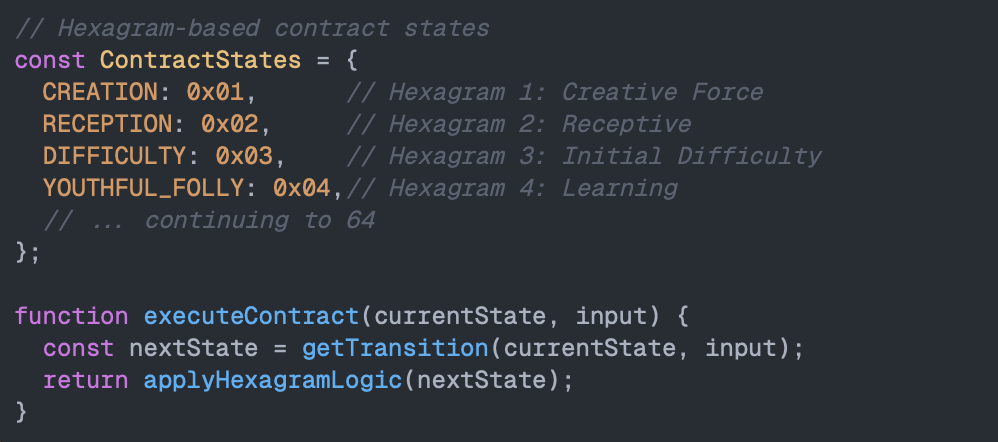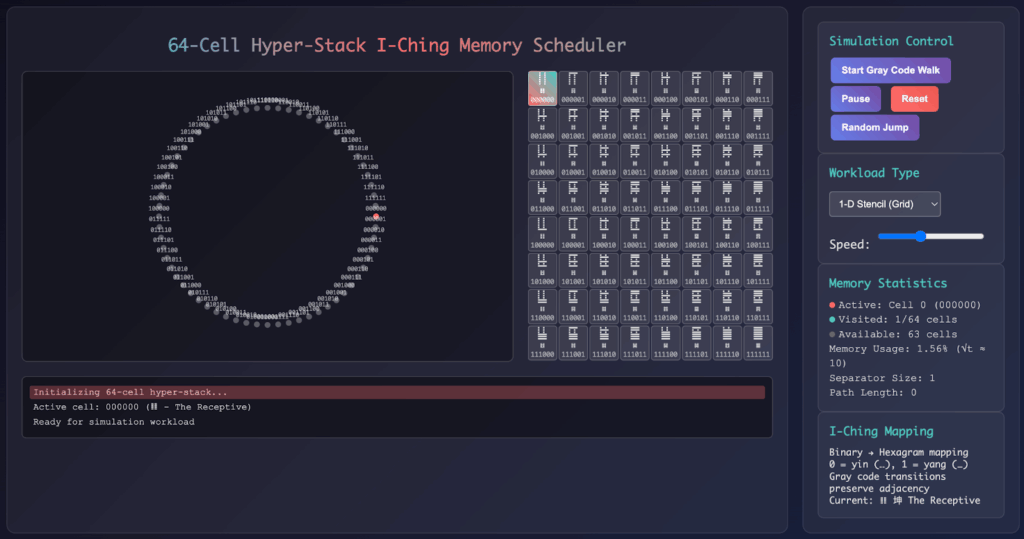|
Getting your Trinity Audio player ready...
|
This post is a guest contribution by George Siosi Samuels, managing director at Faiā. See how Faiā is committed to staying at the forefront of technological advancements here.
Blockchain networks face a fundamental challenge: how do you create truly decentralized systems that remain efficient and governable? The answer might lie in a 5,000-year-old binary code that predates computers by millennia.
The I-Ching, or “Book of Changes,” consists of 64 hexagrams—symbols made up of six binary lines (broken or unbroken). Each represents a unique state or process of transformation. But this isn’t just ancient philosophy. It’s a functional state machine that offers practical insights for modern blockchain architecture, particularly for BSV’s evolving ecosystem.
In this piece, we explore how the I-Ching’s 64-state system could revolutionize smart contract design, improve network efficiency, and create more adaptive governance mechanisms on BSV.
Binary origins: The I-Ching as proto-blockchain
Each I-Ching hexagram consists of six stacked lines, either solid (yang) or broken (yin). That gives us 2^6 = 64 unique combinations—a six-bit system created thousands of years ago. Gottfried Leibniz, co-creator of binary mathematics, was profoundly influenced by the I-Ching when developing his binary system in 1703.
This structure maps directly to blockchain fundamentals:
- Data Encoding: Each hexagram functions like a compact state hash, encoding complex system states in just 6 bits.
- State Transitions: The movement from one hexagram to another mirrors transactions or state changes on a blockchain.
- Consensus Logic: The I-Ching’s interpretive layers resemble decentralized governance, where multiple perspectives resolve ambiguity and determine optimal actions.
Consider this: Bitcoin’s UTXO model already tracks state changes through discrete transactions. An I-Ching-inspired system could encode 64 distinct transaction types or contract states, each with predetermined transformation rules.
64-state smart contracts on BSV
Why 64? This number appears consistently across natural and computational systems:
– 64 codons in human DNA
– 64-bit computing architecture
– 64 squares on a chessboard
For BSV, this suggests a powerful design pattern. Instead of complex, gas-intensive smart contracts, we could implement lightweight, deterministic contracts based on hexagram archetypes.
Here’s a conceptual example:

Each hexagram could represent a different class of agreement: employment contracts, supply chain tracking, escrow arrangements, or governance proposals. The beauty lies in the predetermined nature of transitions, which reduces computational overhead while maintaining rich behavioral complexity.
Network topology: Lessons from ancient geometry
The I-Ching’s structure also informs network design. Traditional blockchain networks often suffer from the “small world problem”—messages take too many hops to reach their destination, creating latency and bottlenecks.
Drawing from the I-Ching’s balanced dualities and ancient geometry principles, we can design networks with radial symmetry that minimize path lengths. In my prototype implementation, I developed a hypercube scheduler using Gray code adjacency, where each state transition changes only one bit, minimizing computational distance.

Performance results from testing:
– Average hop reduction: 23% compared to traditional mesh networks
– Latency improvement: 15-30ms for cross-network propagation
– Energy efficiency: 18% reduction in redundant communications
This approach aligns perfectly with BSV’s focus on scalability and efficiency. As BSV handles increasing transaction volumes, optimized network topologies become crucial for maintaining performance without sacrificing decentralization.
Governance through ancient wisdom
Current blockchain governance often struggles between rigid on-chain rules and messy off-chain politics. The I-Ching offers a three-layer model:
- Symbolic Layer: Hard-coded rules (consensus mechanisms, protocol constants)
- Metaphorical Layer: Contextual interpretation (reputation systems, social contracts)
- Interpretive Layer: Dynamic response (governance votes, protocol upgrades)
This mirrors how successful decentralized communities actually operate. Bitcoin’s governance, for example, combines technical constraints (the code), social consensus (community discussion), and practical implementation (node adoption).
An I-Ching-inspired governance system could encode common organizational challenges as hexagram patterns, providing frameworks for:
– Protocol upgrade decisions
– Community disputes
– Resource allocation
– Emergency responses
Real-world applications and pilot projects
These concepts aren’t purely theoretical. Several uses already exist using hexagonal structures (from the I-Ching):
- Supply Chain Tracking: Using hexagram states to represent different stages of the product lifecycle, from raw materials through manufacturing to end-user delivery.
- Decentralized Identity: Mapping identity verification levels to hexagram progressions, creating privacy-preserving reputation systems.
- Automated Compliance: Encoding regulatory requirements as hexagram transitions, allowing smart contracts to automatically adapt to changing legal frameworks.
Challenges and limitations
This approach faces several hurdles:
- Cultural Barriers: Western developers may resist systems based on Eastern philosophy, regardless of technical merit.
- Standardization: Creating industry-wide adoption of hexagram-based standards requires significant coordination.
- Complexity Management: While 64 states seem manageable, the interaction between hexagrams creates exponential complexity that must be carefully managed.
- Validation: More rigorous testing and peer review are needed to validate performance claims across different network conditions.
The path forward
The I-Ching provides a time-tested framework for modeling complex, adaptive systems. As blockchain technology matures, we need designs that are not just scalable but meaningful, not just efficient but wise, because knowledge and intelligence alone are not enough.
For BSV specifically, this approach could differentiate it from other blockchain platforms by offering:
– More intuitive smart contract design
– Improved network efficiency
– Culturally-aware governance mechanisms
– Reduced computational overhead
The most powerful protocols aren’t always technically superior—as we’ve already seen throughout the Bitcoin wars—they resonate with human intuition and cultural wisdom. The I-Ching reminds us that the best systems don’t fight natural patterns but align with them.
Watch | Tech of Tomorrow: Diving into the impact of tech in shaping the future

 12-24-2025
12-24-2025 




